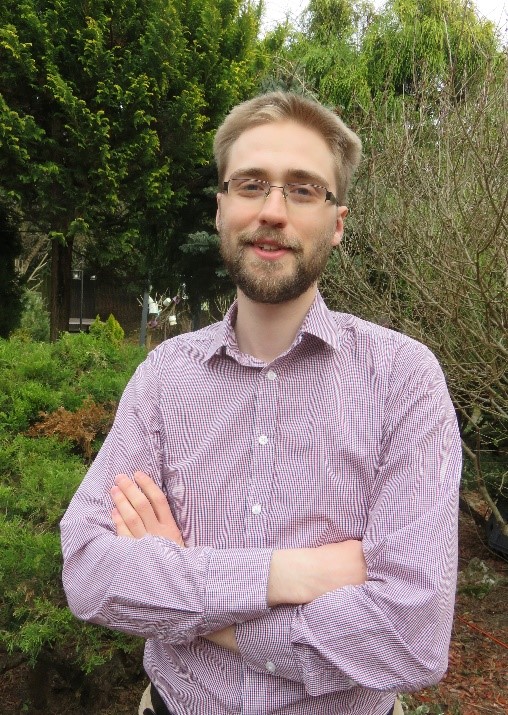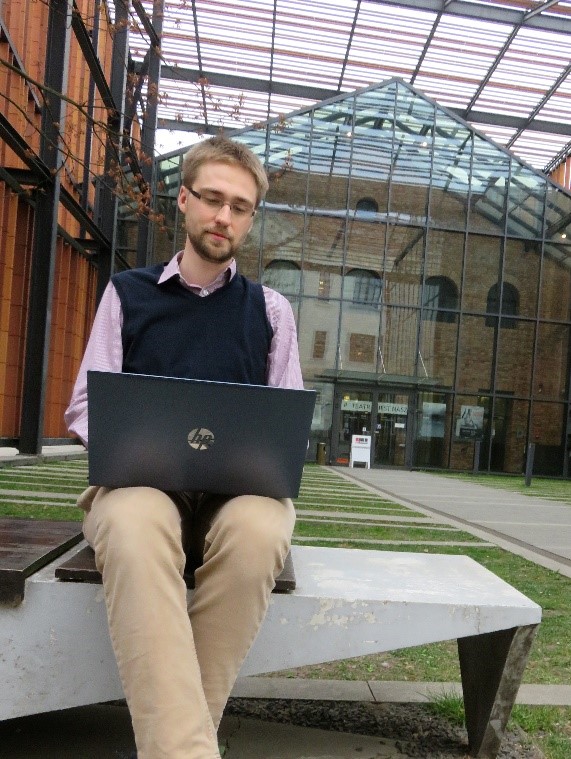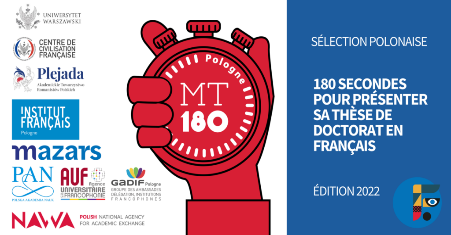Kamil Bieniek, a PhD candidate from the IPPT PAN Department of Mechanics of Materials has won the second prize in the Polish edition of the French competition “My Doctorate in 180 seconds” and qualified for the Central Europe finals!!

Kamil Bieniek graduated from the Civil Engineering department at Cracow University of Technology. He finished both his Bachelor’s (B.Sc) and Master’s (M.Sc) studies with distinction. In 2019 he commenced a PhD course in the Doctoral School of IPPT PAN, under the supervision of Dr. hab. Katarzyna Kowalczyk-Gajewska, prof. IPPT PAN. Currently, he is in his third year of studies.
The student has broad linguistic skills and quickly learns new languages. He can fluently speak English and French, as well as Swedish, German and Czech on other levels. As he says, the knowledge of foreign languages has offered him various opportunities in the past, as this competition demonstrates. In his curriculum, he also has a position of an academic teacher at his home university, where he used to teach the basics of the Finite Elements Method, as well as how to use dedicated software for engineers. That allowed him to gain didactic experience on how to transfer the knowledge in a comprehensible way. His PhD covers the Mechanical Engineering discipline and it aims for development of effective procedures for finding optimal microstructures regarding possible applications of composite materials.
For these purposes, his work assumes a use of the Cluster model. It is an analytical micromechanical model for the assessment of elastic and thermal properties of heterogeneous materials composed of a matrix with spherical inclusions. Compared to classical micromechanical models, the Cluster model allows for taking into account i.a. the size effects and spatial distribution of inclusions within the sample. The spatial distribution of inclusions (regular or random) is defined with representative unit cells that - alongside with material parameters of phases - are the input data for the model. The results are homogenised macroscopic parameters of the composite, such as: elastic stiffness moduli, thermal conductivity, coefficient of thermal expansion or yield stress.
For verification of the cluster model, a numerical homogenisation is performed using the Finite Elements Method (FEM). Simulations are performed for equivalent unit cells and the results - similarly to the analytical model - are the macroscopic characteristic of the composite. Comparison between the two approaches allows for the definition of a precision level, as well as a range of application for the Cluster model.
It is worth noting that the numerical approach is less resource-efficient and more time-consuming, which is the reason for the development of analytical models and optimisation methods based on them. Use of quick analytical computational tools allows for testing many scenarios (e.g. modifying parameters of phases, spatial distribution of inclusions or their volume fraction) and finding optimal solutions depending on the foreseen applications for the given composite.
The objective of the contest “My thesis in 180 seconds” was to introduce to a wide audience the subject of the research, in French and in simple language. Each participant had to do this in three minutes. This year, the contest was held on-line.
 |
 |
During the presentation, that had to have a science-popularising character, our laureate (2nd place) described his PhD in following words:
…“The world is complex! Even if we don’t think about this on a daily basis, once we try to describe how everything works, we find an immense level of complexity. In my field of studies - mechanics of materials - scientists and engineers in their daily work try to translate this complex reality into the simplest possible language.
If we want to build something - a building or a mechanism - we need to know the parameters of the material that we use. If it’s a homogenous material, like steel for example, it’s not that big problem, because we have known about them for decades. However, if it’s a composite - well, that’s a different story.
In my thesis I concentrate on composites that are composed of a matrix reinforced by dispersed spherical inclusions. In order to predict their behaviour, I use the “Cluster” model. It’s an analytical model proposed by two French scientists: Alain Molinari and Moustapha El Mouden from the University of Metz. It takes into consideration the interactions between inclusions and - by homogenisation - allows us to describe the behaviour of the entire composite on the global level. I try to describe the mathematical behaviour of the model, as well as the processes of optimisation.
But these models - what do they give us? Today, with powerful computers, we are able to produce very detailed and reliable numerical models. Unfortunately, it’s not for free - they take time: a single calculation can even take up to several days! For everyday work for an engineer this is too long.
On the contrary, if we had access to models that are quick, efficient and reliable, we could save a lot of resources. Let’s imagine a wall made of composite - we need a material that is durable and solid, while at the same time being a good thermal insulator. With such quick calculations we would be able to test multiple possible combinations and by manipulating e.g.: parameters of the matrix, parameters of the inclusions, their spatial layout or volume fraction, we could find the most optimal solution for our case.
This particular search for an optimum is what pushes the need for further research. Personally, I’m convinced - we need models that are simple and efficient. All with the aim to describe reality in its entire complexity…“
___________
The organizers of the competition are:
Institut Français de Pologne -> https://www.institutfrancais.pl/
Centre de civilisation française -> https://okf.uw.edu.pl/fr/,
Association académique des romanistes polonais « Plejada » -> https://plejada.romanisci.edu.pl/
More about the competition : www















